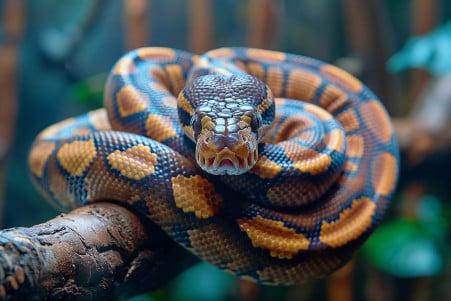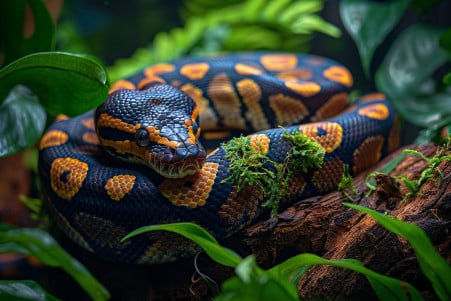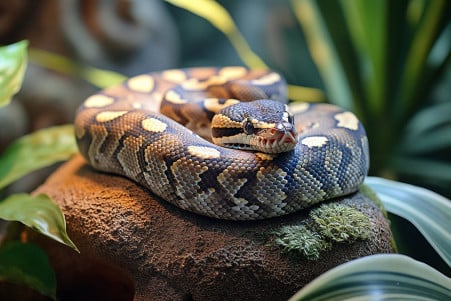The Best Humidity for Ball Pythons: How to Get It Just Right
9 February 2024 • Updated 7 February 2024

Getting the humidity just right for ball pythons requires a mix of art and science. Ball pythons need to be in an environment that is between 50–60% humidity, although it can be raised to 65% during shedding to help ensure that their skin comes off in one piece. To keep the humidity at the right level, you’ll need to use a hygrometer to measure it, mist the enclosure, and use humidity-friendly substrates like coconut husk.
This article will take a deep dive into herpetoculture, environmental science, and biology to explain how to maintain the best humidity for ball pythons. We’ll cover the way different substrates impact humidity, how the design of the enclosure impacts the microclimate, and even look at the science behind how these snakes interact with their environment.
The goal is to give you the information you need to set up the best possible home for your ball python.
What are the best ways to control humidity for ball pythons?
Understanding the Humidity Requirements of Ball Pythons
Ball pythons are native to the grasslands and open forests of West and Central Africa, which are areas of high humidity, especially during the wet season. As a result, in the wild, ball pythons have adapted to humidity levels that fluctuate but are generally somewhere between moderate and high.
This is further supported by the fact that according to Animal Diversity Web, ball pythons are known to spend a lot of time in burrows, which naturally help to regulate humidity and are important for their overall health.
The skin of the ball python is more than just a protective layer; according to a paper published in PMC, it also acts as a barrier to water loss and pathogens. This makes maintaining the right humidity level important for enabling the natural shedding process and supporting respiratory health, which can be compromised by issues like retained shed and respiratory infections that can be caused by low humidity.
This can make it difficult for owners to maintain the right humidity levels in captivity, where they need to work to maintain the right humidity levels in the snake’s enclosure, which often involves manipulating the microclimate of the enclosure. This can be done by using substrates, setting up enclosures, and controlling the environment to ensure that ball pythons are able to maintain the right level of hydration.
Going forward, understanding the importance of substrates will be key to controlling the delicate humidity balance in a ball python’s enclosure.
Getting the Right Moisture Balance: Substrate Options for Ball Python Enclosures
One of the most important parts of maintaining the right humidity levels in your ball python’s enclosure is choosing the right substrate. Information on substrates shows that the best options like Orchid Bark, Cypress Mulch, and Coconut Husk all have different qualities that make them good at holding moisture.
Orchid Bark, which comes from fir trees, decomposes slowly, so it’s a great option for humid environments. Cypress Mulch is lightweight and great for burrowing reptiles, and it can absorb and release moisture to help keep the humidity in the enclosure at the right level.
Coconut Husk, which comes in fine and chunky varieties, is even better at holding moisture than the other two substrates, so it’s a great option for environments that need to be kept very humid.
Exo Terra notes that the role of the substrate goes beyond just the look of the enclosure and even includes encouraging natural behaviors and helping with thermoregulation.
When you’re choosing and mixing substrates, it’s important to think about how much moisture your ball python needs and make sure that you’re not going to end up with a substrate that’s too wet and could cause respiratory problems.
It’s also important to make sure that you keep up with regular maintenance to make sure that the substrate doesn’t get moldy or develop bacteria, which could make your pet sick and make the enclosure unsanitary. By learning about the properties of each type of substrate, you can create a microclimate that’s both controlled and comfortable for your ball python.
Building Humidity-Regulated Habitats for Ball Pythons
The type and construction of your ball python’s habitat can make a big difference in your ability to regulate humidity. While glass tanks are a popular choice, they can be harder to maintain humidity in because they are more likely to allow for better airflow, which can dry out the tank. On the other hand, PVC cages are known for their insulating properties that help maintain consistent humidity levels, according to Vision Products.
When trying to maintain humidity without adding too much moisture, you should also think about the ventilation and water source placement in your habitat. Vents can be placed in certain areas to help with air exchange without dropping humidity too much, and the size of the water bowl can be adjusted to help control the rate of evaporation in the habitat.
Terrarium Quest recommends finding a good balance between ventilation and humidity to make sure your ball python has a healthy environment.
It’s also important to use environmental control equipment like humidifiers and hygrometers to make sure you’re regulating humidity as accurately as possible. Humidifiers, especially those made for reptiles, can be used in larger habitats or when you’re trying to raise humidity levels temporarily, like during a shedding period.
Vision Products also recommends using a hygrometer, which is a must-have for monitoring your habitat and making sure that humidity stays between the ideal 60–70% range. If you’re able to manage these factors effectively, you can create an environment that will help your ball python stay healthy and exhibit natural behaviors.
How Humidity Affects Ball Python Health
Ball pythons display a variety of physiological changes in response to humidity levels, all of which have direct implications for their health and well-being.
An article in ScienceDirect notes that reptiles, including ball pythons, are at risk for dermatological problems such as dysecdysis, which is when an animal has trouble shedding its skin, when humidity is not at the proper level. In low humidity, ball pythons may not be able to shed their skin properly, which can lead to infections or retained shed, which can be uncomfortable and even painful for the snake.
Low humidity also makes ball pythons more susceptible to respiratory infections because reptile skin, including that of ball pythons, needs a certain level of moisture to maintain its protective properties.
An article in IntechOpen notes that reptile skin, which is covered in keratinized scales, is highly effective at preventing water loss and dehydration. However, if the humidity is too low, the skin’s protective properties can be compromised, which can make the reptile more susceptible to infections and stress.
A study published in Frontiers in Zoology found that hydration is important for reptile immune function. A study on desert reptiles found that the reptiles’ hydration status had a significant impact on their immune function, which suggests that maintaining the proper humidity levels is important for ball python health.
In summary, maintaining the proper humidity levels is important not only for the ball python’s comfort but also for ensuring that the reptile is in an environment that supports its overall physiological health, including immune function and skin health. This knowledge of their needs ensures that these reptiles can live a long and healthy life in captivity.
Increasing Humidity Through Enrichment
Environmental enrichment enriches the ball python’s captive environment by meeting their physical needs while also satisfying the instinctual behaviors they would normally display in the wild. As described in a study posted on ScienceDirect, it is a flexible and dynamic process that enriches the lives of the snakes by enabling natural behaviors and improving welfare.
Enrichment elements like live plants increase the humidity in the enclosure through transpiration, and other elements like water bowls and misters enable the creation of a microclimate that matches the humidity of the ball python’s natural environment.
Zen Habitats notes that enrichment, like climbing branches and hides, not only enriches the snake’s life but also helps maintain the desired humidity by reducing airflow and creating pockets of humidity. For example, a larger water bowl will encourage the snakes to swim— a natural behavior— and will also increase the humidity in the air.
It’s important to find a balance, as noted in The IAABC Journal, that ensures that the enrichments don’t overwhelm or stress the ball python. However, when keepers thoughtfully choose and place enrichments, they can create an environment that will keep the ball python happy and the humidity at the right level, creating an environment that will enable the snake to live its best life.
Taking Care of Your Ball Python: A Review of the Most Important Things to Know About Humidity
As we’ve discussed, humidity plays a crucial role in a ball python’s health and well-being. We’ve learned that maintaining a humidity level of 50–60% is ideal, although it’s important to increase it to 60–65% during shedding to help with skin issues and respiratory problems.
If the humidity is too low, ball pythons can experience a number of health issues, including bad sheds and respiratory infections, as Animal Diversity Web and research in Frontiers in Zoology have pointed out.
To ensure that you’re being a good pet owner, it’s important to make sure that you’re constantly monitoring and adjusting the humidity levels, using hygrometers to help you, and misting to make sure that the levels stay where they need to be.
A good care routine that will help ensure that your ball python lives a long and happy life includes picking the right substrates, setting up the right kind of enclosure, and making sure that you’re providing environmental enrichment.
When we take on the responsibility of caring for these amazing animals, it’s important to remember that we need to do our best to recreate their natural habitats in our homes. Not only will this help ensure that our reptilian friends are happy and healthy, but it will also help us learn more about and appreciate the nuances of their needs.


